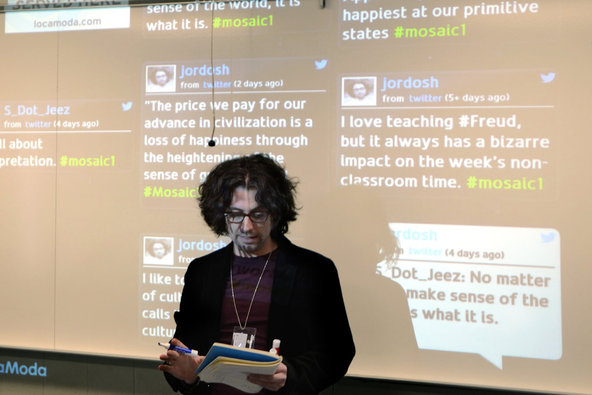 The Philadelphia Inquirer reports about a Temple University instructor who engages his students with Twitter during class.
The Philadelphia Inquirer reports about a Temple University instructor who engages his students with Twitter during class.
Jordan Shapiro’s class last week delved into a weighty discussion of Plato’s allegory of the cave and shifting perceptions of reality. Front and center on the classroom wall behind him flashed a constantly shifting series of posts on Twitter, all under the class hashtag of #Mosaic1. With her Nook and phone at hand, sophomore Kaylyn Christian, 20, tweeted: “Are you really happy if you live a successful life in the shadows?” Shapiro’s Temple University classroom is definitely not the norm in academia, but it could be a harbinger of the future. While many professors at Temple and beyond ban tweeting and texting in class, Shapiro, a full-time instructor who started last year, encourages it. Even more so – he counts it as classroom participation. He often tweets back. “Please tweet. Please do it,” Shapiro, 35, tells students at the start of the semester. Christian, a psychology major from Princeton, is happy to comply. “I always like to look up at the screen,” she said, “and see what others are saying, too.”
In Forbes, Shapiro writes:
As I prepare my syllabi for the upcoming semester, I take a different approach. I encourage tweeting in my classes. I offer hashtags that correspond to the name of the course at the beginning of the semester (#mosaic1 & #mosaic2). Students are asked to tweet their thoughts and reactions both during class and while doing readings at home. I see it like a modern day version of the reading journals that my professors always assigned.
I sometimes use the smart classroom technology to project the class related tweet stream onto the screen behind me during session. This is pretty exciting when it works well. Like every tech industry conference I’ve ever attended, two levels of dialogue are going on at once. Imagine: students are not just engaged with the material, they’re engaged twice. I’m facilitating a live conversation and they are facilitating the tweet stream.
I have been using a live-chat in class now for some time (here are some of my early posts). I do not use Twitter, as I do not require students to sign up. Rather, I use a program called Today’s Meet, which allows me to create quick, easy, anonymous chats. Students are able to ask questions, send me links to relevant articles, tell me when I’m wrong anonymously (it happens!), and even injet some humor into the discussion (something I appreciate). Students are already on their computers, chatting away. How many professors wish they knew what was going on in their student’s minds (in class, at least)? With the live-chat, I can see what they are thinking, and become a better teacher for it.
 For example, here are some of the tweets from when I covered life estates the other day.
For example, here are some of the tweets from when I covered life estates the other day.
When a question is posted online, I see it on my screen, and decide when and how I want to address it. But it allows me to better control the pacing of the class.
I also allow students to provide feedback to me, anonymously, at various points throughout the semester so I know how I am doing. This is a quick and easy way to make improvements on the fly.
This is not easy. It requires me to juggle a lot of balls at once. First, I have to teach the class. Second, I have to type up the notes in real-time (something I do using Google docs). Third, I have to keep the students engaged. I do not do Socratic. Rather, I go up and down each row and ask everyone one question. I can call on about 80-90 people per class, so everyone is called on every day. Sometimes twice. Fourth, I monitor the livechat to see if there is anything else to bring up.
You can view the home pages for my Property 1 class here, and my Property 2 class here.